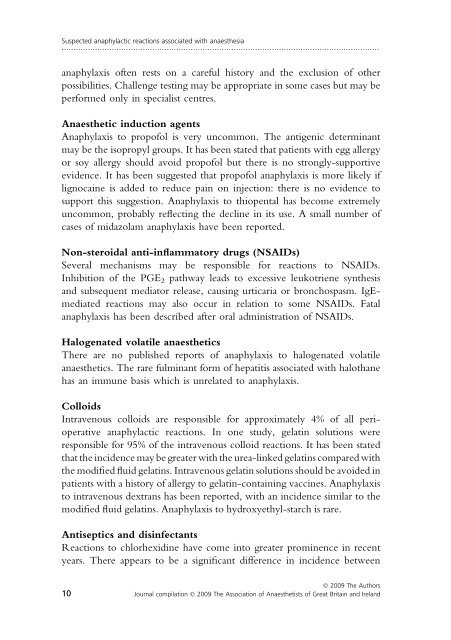Suspected anaphylactic reactions associated with anaesthesia - aagbi
Suspected anaphylactic reactions associated with anaesthesia - aagbi
Suspected anaphylactic reactions associated with anaesthesia - aagbi
- No tags were found...
You also want an ePaper? Increase the reach of your titles
YUMPU automatically turns print PDFs into web optimized ePapers that Google loves.
<strong>Suspected</strong> <strong>anaphylactic</strong> <strong>reactions</strong> <strong>associated</strong> <strong>with</strong> <strong>anaesthesia</strong>.....................................................................................................................................anaphylaxis often rests on a careful history and the exclusion of otherpossibilities. Challenge testing may be appropriate in some cases but may beperformed only in specialist centres.Anaesthetic induction agentsAnaphylaxis to propofol is very uncommon. The antigenic determinantmay be the isopropyl groups. It has been stated that patients <strong>with</strong> egg allergyor soy allergy should avoid propofol but there is no strongly-supportiveevidence. It has been suggested that propofol anaphylaxis is more likely iflignocaine is added to reduce pain on injection: there is no evidence tosupport this suggestion. Anaphylaxis to thiopental has become extremelyuncommon, probably reflecting the decline in its use. A small number ofcases of midazolam anaphylaxis have been reported.Non-steroidal anti-inflammatory drugs (NSAIDs)Several mechanisms may be responsible for <strong>reactions</strong> to NSAIDs.Inhibition of the PGE 2 pathway leads to excessive leukotriene synthesisand subsequent mediator release, causing urticaria or bronchospasm. IgEmediated<strong>reactions</strong> may also occur in relation to some NSAIDs. Fatalanaphylaxis has been described after oral administration of NSAIDs.Halogenated volatile anaestheticsThere are no published reports of anaphylaxis to halogenated volatileanaesthetics. The rare fulminant form of hepatitis <strong>associated</strong> <strong>with</strong> halothanehas an immune basis which is unrelated to anaphylaxis.ColloidsIntravenous colloids are responsible for approximately 4% of all perioperative<strong>anaphylactic</strong> <strong>reactions</strong>. In one study, gelatin solutions wereresponsible for 95% of the intravenous colloid <strong>reactions</strong>. It has been statedthat the incidence may be greater <strong>with</strong> the urea-linked gelatins compared <strong>with</strong>the modified fluid gelatins. Intravenous gelatin solutions should be avoided inpatients <strong>with</strong> a history of allergy to gelatin-containing vaccines. Anaphylaxisto intravenous dextrans has been reported, <strong>with</strong> an incidence similar to themodified fluid gelatins. Anaphylaxis to hydroxyethyl-starch is rare.Antiseptics and disinfectantsReactions to chlorhexidine have come into greater prominence in recentyears. There appears to be a significant difference in incidence betweenÓ 2009 The Authors10 Journal compilation Ó 2009 The Association of Anaesthetists of Great Britain and Ireland

















